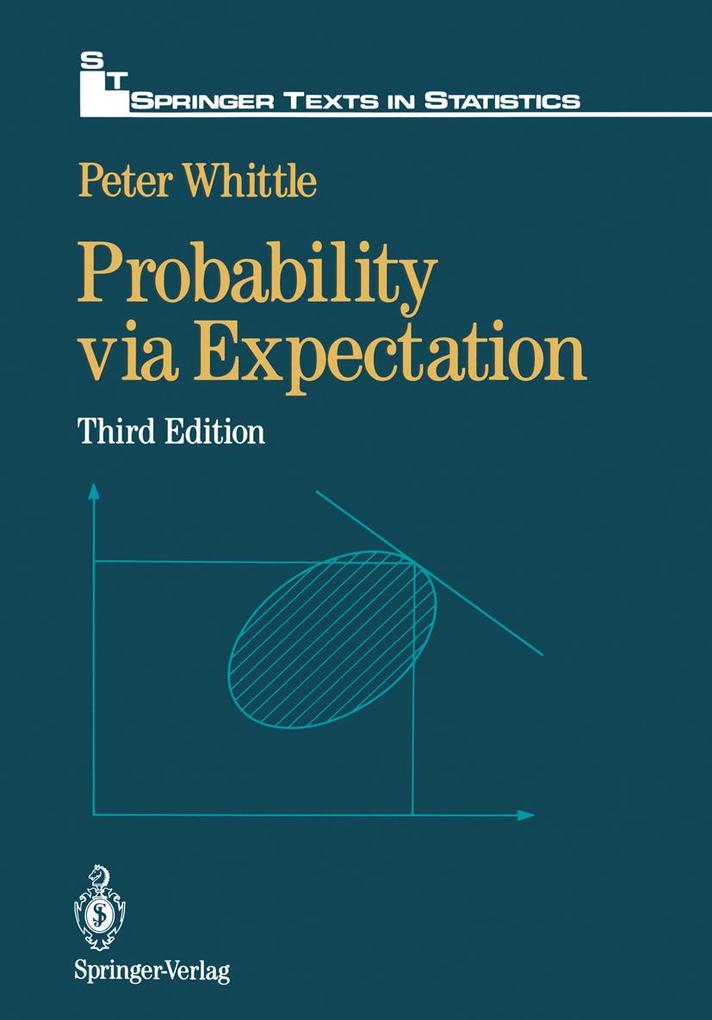This book is a complete revision of the earlier work Probability which ap peared in 1970. While revised so radically and incorporating so much new material as to amount to a new text, it preserves both the aim and the approach of the original. That aim was stated as the provision of a 'first text in probability, de manding a reasonable but not extensive knowledge of mathematics, and taking the reader to what one might describe as a good intermediate level'. In doing so it attempted to break away from stereotyped applications, and consider applications of a more novel and significant character. The particular novelty of the approach was that expectation was taken as the prime concept, and the concept of expectation axiomatized rather than that of a probability measure. In the preface to the original text of 1970 (reproduced below, together with that to the Russian edition of 1982) I listed what I saw as the advantages of the approach in as unlaboured a fashion as I could. I also took the view that the text rather than the author should persuade, and left the text to speak for itself. It has, indeed, stimulated a steady interest, to the point that Springer-Verlag has now commissioned this complete reworking.
Inhaltsverzeichnis
1 Uncertainty, Intuition and Expectation. - 1. Ideas and Examples. - 2. The Empirical Basis. - 3. Averages over a Finite Population. - 4. Repeated Sampling: Expectation. - 5. More on Sample Spaces and Variables. - 6. Ideal and Actual Experiments: Observables. - 2 Expectation. - 1. Random Variables. - 2. Axioms for the Expectation Operator. - 3. Events: Probability. - 4. Some Examples of an Expectation. - 5. Moments. - 6. Applications: Optimization Problems. - 7. Equiprobable Outcomes: Sample Surveys. - 8. Applications: Least Square Estimation of Random Variables. - 9. Some Implications of the Axioms. - 3 Probability. - 1. Events, Sets and Indicators. - 2. Probability Measure. - 3. Expectation as a Probability integral. - 4. Some History. - 5. Subjective Probability. - 4 Some Basic Models. - 1. A Model of Spatial Distribution. - 2. The Multinomial, Binomial, Poisson and Geometric Distributions. - 3. Independence. - 4. Probability Generating Functions. - 5. The St. Petersburg Paradox. - 6. Matching, and Other Combinatorial Problems. - 7. Conditioning. - 8. Variables on the Continuum: the Exponential and Gamma Distributions. - 5 Conditioning. - 1. Conditional Expectation. - 2. Conditional Probability. - 3. A Conditional Expectation as a Random Variable. - 4. Conditioning on ? -Field. - 5. Independence. - 6. Statistical Decision Theory. - 7. Information Transmission. - 8. Acceptance Sampling. - 6 Applications of the Independence Concept. - 1. Renewal Processes. - 2. Recurrent Events: Regeneration Points. - 3. A Result in Statistical Mechanics: the Gibbs Distribution. - 4. Branching Processes. - 7 The Two Basic Limit Theorems. - 1. Convergence in Distribution (Weak Convergence). - 2. Properties of the Characteristic Function. - 3. The Law of Large Numbers. - 4. Normal Convergence (the Central Limit Theorem). - 5. The NormalDistribution. - 8 Continuous Random Variables and Their Transformations. - 1. Distributions with a Density. - 2. Functions of Random Variables. - 3. Conditional Densities. - 9 Markov Processes in Discrete Time. - 1. Stochastic Processes and the Markov Property. - 2. The Case of a Discrete State Space: the Kolmogorov Equations. - 3. Some Examples: Ruin, Survival and Runs. - 4. Birth and Death Processes: Detailed Balance. - 5. Some Examples We Should Like to Defer. - 6. Random Walks, Random Stopping and Ruin. - 7. Auguries of Martingales. - 8. Recurrence and Equilibrium. - 9. Recurrence and Dimension. - 10 Markov Processes in Continuous Time. - 1. The Markov Property in Continuous Time. - 2. The Case of a Discrete State Space. - 3. The Poisson Process. - 4. Birth and Death Processes. - 5. Processes on Nondiscrete State Spaces. - 6. The Filing Problem. - 7. Some Continuous-Time Martingales. - 8. Stationarity and Reversibility. - 9. The Ehrenfest Model. - 10. Processes of Independent Increments. - 11. Brownian Motion: Diffusion Processes. - 12. First Passage and Recurrence for Brownian Motion. - 11 Second-Order Theory. - 1. Back to L2. - 2. Linear Least Square Approximation. - 3. Projection: Innovation. - 4. The Gauss Markov Theorem. - 5. The Convergence of Linear Least Square Estimates. - 6. Direct and Mutual Mean Square Convergence. - 7. Conditional Expectations as Least Square Estimates: Martingale Convergence. - 12 Consistency and Extension: the Finite-Dimensional Case. - 1. The Issues. - 2. Convex Sets. - 3. The Consistency Condition for Expectation Values. - 4. The Extension of Expectation Values. - 5. Examples of Extension. - 6. Dependence Information: Chernoff Bounds. - 13 Stochastic Convergence. - 1. The Characterization of Convergence. - 2. Types of Convergence. - 3. Some Consequences. - 4. Convergence inrth Mean. - 14 Martingales. - 1. The Martingale Property. - 2. Kolmogorov s Inequality: the Law of Large Numbers. - 3. Martingale Convergence: Applications. - 4. The Optional Stopping Theorem. - 5. Examples of Stopped Martingales. - 15 Extension: Examples of the Infinite-Dimensional Case. - 1. Generalities on the Infinite-Dimensional Case. - 2. Fields and ? -Fields of Events. - 3. Extension on a Linear Lattice. - 4. Integrable Functions of a Scalar Random Variable. - 5. Expectations Derivable from the Characteristic Function: Weak Convergence. - 16 Some Interesting Processes. - 1. Information Theory: Block Coding. - 2. Information Theory: More on the Shannon Measure. - 3. Information Theory: Sequential Interrogation and Questionnaires. - 4. Dynamic Optimization. - 5. Quantum Mechanics: the Static Case. - 6. Quantum Mechanics: the Dynamic Case. - References.













